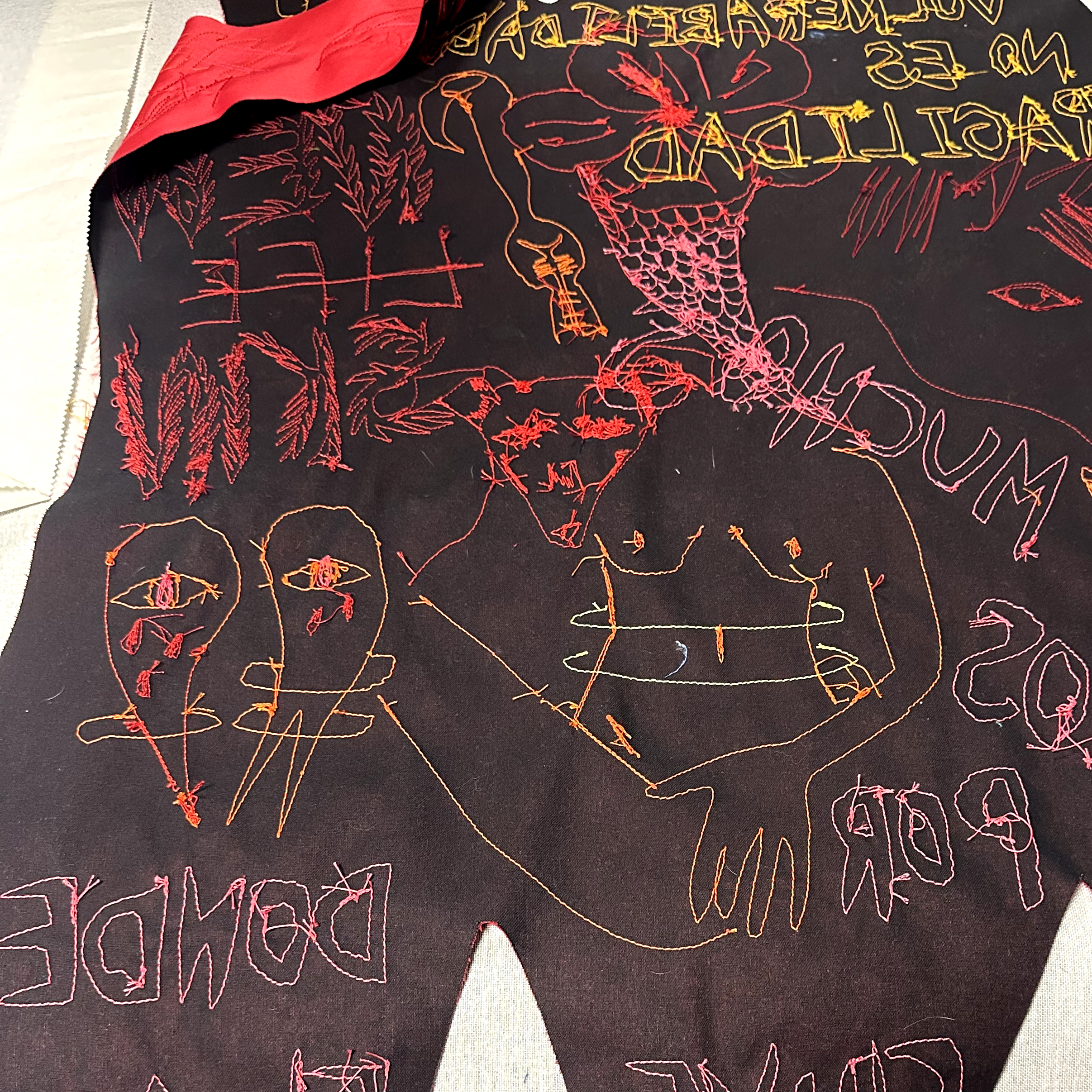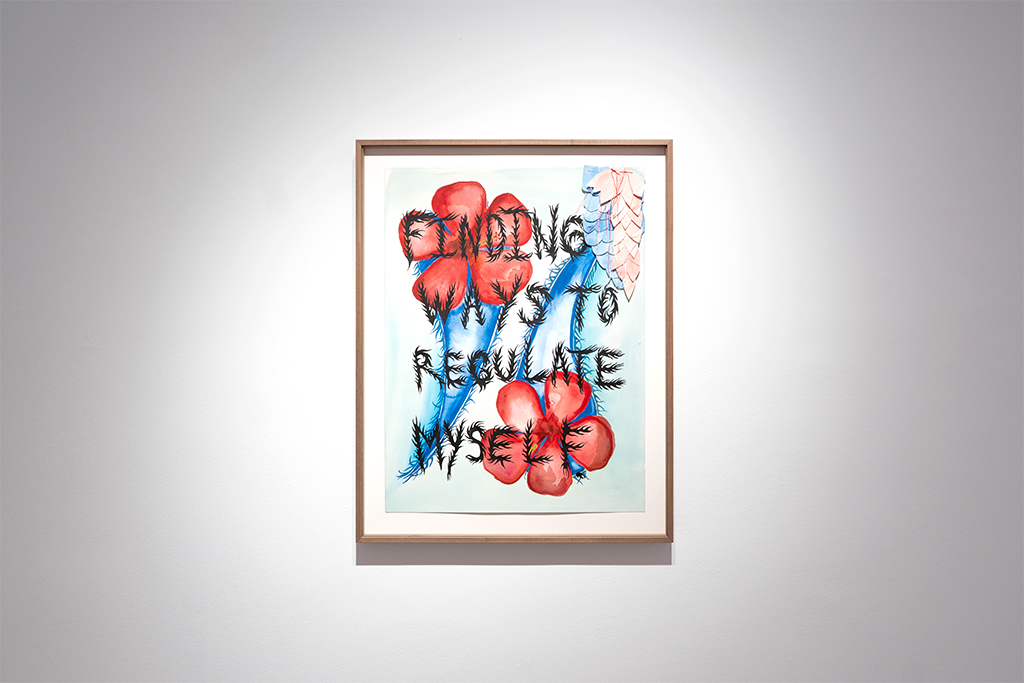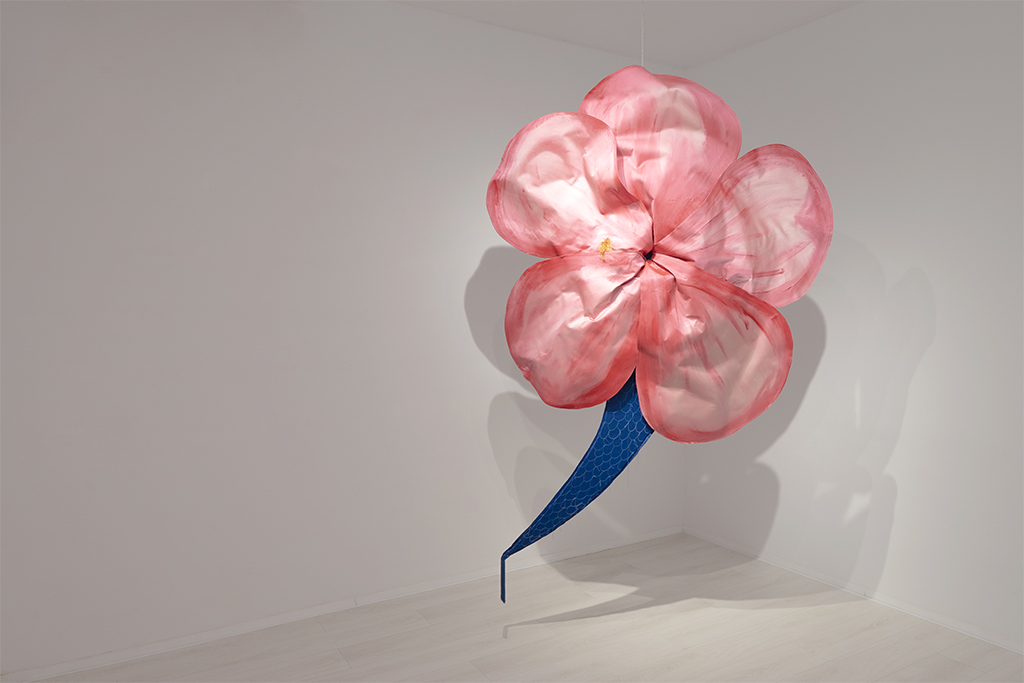
Gema Polanco, view of the studio, november 2025 © the artist





Gema Polanco, view of the solo show Amor, mira como vivo, 2025 © the artist, courtesy galería MPA, Madrid.
This text accompanies the solo exhibition by artist Amor mira como vivo from November 15, 2025 to January 17, 2026 at the MPA - Moisés Pérez Albéniz gallery in Madrid in November 2025.
Websites of the artist and the gallery
Gema Polanco
Galería MPA - Moisés Pérez Albéniz
My my, hey
hey
Rock and roll is here to stay
It's better to burn out than to fade away1
…
My, my, hey, hey — music and memory are spinners of stories too. 22022022 is the day I met Gema Polanco. BOOM. Bright blazing red and incorruptible blue. Textile, drawing, body, poetry, flame, vulva, word, tear, and the silhouette of Nick Cave — all that living matter filled her Madrid studio. Since then, whenever my eye catches that red, that blue, a piece of fabric, I’m taken back there instantly, with a melody, a gesture lingering in the background. It’s like recognizing a note in a score before even recalling the song.
The plural artist unfolds her work across visual forms as much as in garments, writing, and exhibition design — how could one not think of the one dedicated a few years ago to the band The National, and by extension, to Ragnar Kjartansson’s performance2. Exhaustion of the body, repetition, precise signs trace the work; I like to enter this exhibition, Amor mira como vivo, through the figure of the alter ego. Present in her practice for a long time, multiplied across media, repeated in its representations, exhausted through emotion; at once an ideal self and a catharsis, supremacy and alienation — the alter ego, the half-sovereign tattooed with scales, confronts us. Gema Polanco questions the other as a reflection — both true and deceiving — an exploration of multiple and fragmented identities, a possibility for another world. The alter ego as heir to pain, transition, betrayal, hope, change, and healing.
Embroidery thread as thread of speech, fifty years after Annette Messager’s Ma collection de proverbes — an embroidered anthology of misogynistic phrases that shape societies — Gema Polanco lays down phrases, sometimes slogans (punk), sometimes aphorisms, poems, incantations, melodies, and comforting spells. But whereas her work exposes and evokes phallocentrism and the place of women and the feminine, Messager always stands at a measured distance, while others — from Louise Bourgeois to Nan Goldin to Tracey Emin — draw from their lives, their emotions, their intimate worlds. Gema Polanco belongs to this lineage that proves an introspective, autobiographical work can also be the most universal. And even if she sews and embroiders as Burroughs and Bowie did with cut-up, she also dares to dive in, does not hide, accepts exposure. The artist holds a steady stance — confronting doubts, difficulties, and emotions, speaking of weakness and sorrow as much as beauty. Words, thread as ink, and feminine strength all claim that vulnerability is not fragility. ¿Entiendes?
Confía Tía! 3
I like to read and look at the artist’s work through this lens, naturally connecting it to Nietzsche’s thought. As for us, what does not kill Gema Polanco makes her stronger4; it is this very evidence I perceive in the dialogue between the works — that of the transvaluation of values and the creation of the self. Watercolors, mobiles, tapestry, and talismans celebrate life, strength, the capacity to reinvent oneself, the will to overcome one’s own limits; to reinterpret suffering and emerge more lucid, more alive. Life is a becoming. Gema Polanco gives birth to a dancing star — nothing feels truer to Nietzsche’s reflection on creation than when I look at her work, her path. Indeed, One must still have chaos in oneself to be able to give birth to a dancing star5 — and that is what her latest works embrace, from a monumental tapestry to a series of collages, small lucky charms, benevolent oracles.
I’ve always had a fascination with the needle, the magic power of the needle. The needle is used to repair damage. It’s a claim to forgiveness.6 The needle as reconciliation: with oneself, one’s body, the world, feelings, passions, others — those who surround, love, betray. Spinning, sewing, weaving, embroidery are constitutive of Gema Polanco’s work. As with Louise Bourgeois, here the needle serves as a vector of healing, each stitch like a suture.
Immediately recognizable through her blue and red — long bipolar — palette, the range opens. Red softens to rose, blue diffuses, yellow and gold appear in counterpoint. Sacred traces, drops, blood and reversed tears, pleasure, orgasm, botany, Rona, a swallow, a hand upon a horse — a Prévert-style inventory7 hides within the flame-wings of the alter ego, for those who discern it.
Rock and roll is here to stay
It's better to burn out than to fade away1
…
My, my, hey, hey — music and memory are spinners of stories too. 22022022 is the day I met Gema Polanco. BOOM. Bright blazing red and incorruptible blue. Textile, drawing, body, poetry, flame, vulva, word, tear, and the silhouette of Nick Cave — all that living matter filled her Madrid studio. Since then, whenever my eye catches that red, that blue, a piece of fabric, I’m taken back there instantly, with a melody, a gesture lingering in the background. It’s like recognizing a note in a score before even recalling the song.
The plural artist unfolds her work across visual forms as much as in garments, writing, and exhibition design — how could one not think of the one dedicated a few years ago to the band The National, and by extension, to Ragnar Kjartansson’s performance2. Exhaustion of the body, repetition, precise signs trace the work; I like to enter this exhibition, Amor mira como vivo, through the figure of the alter ego. Present in her practice for a long time, multiplied across media, repeated in its representations, exhausted through emotion; at once an ideal self and a catharsis, supremacy and alienation — the alter ego, the half-sovereign tattooed with scales, confronts us. Gema Polanco questions the other as a reflection — both true and deceiving — an exploration of multiple and fragmented identities, a possibility for another world. The alter ego as heir to pain, transition, betrayal, hope, change, and healing.
Embroidery thread as thread of speech, fifty years after Annette Messager’s Ma collection de proverbes — an embroidered anthology of misogynistic phrases that shape societies — Gema Polanco lays down phrases, sometimes slogans (punk), sometimes aphorisms, poems, incantations, melodies, and comforting spells. But whereas her work exposes and evokes phallocentrism and the place of women and the feminine, Messager always stands at a measured distance, while others — from Louise Bourgeois to Nan Goldin to Tracey Emin — draw from their lives, their emotions, their intimate worlds. Gema Polanco belongs to this lineage that proves an introspective, autobiographical work can also be the most universal. And even if she sews and embroiders as Burroughs and Bowie did with cut-up, she also dares to dive in, does not hide, accepts exposure. The artist holds a steady stance — confronting doubts, difficulties, and emotions, speaking of weakness and sorrow as much as beauty. Words, thread as ink, and feminine strength all claim that vulnerability is not fragility. ¿Entiendes?
Confía Tía! 3
I like to read and look at the artist’s work through this lens, naturally connecting it to Nietzsche’s thought. As for us, what does not kill Gema Polanco makes her stronger4; it is this very evidence I perceive in the dialogue between the works — that of the transvaluation of values and the creation of the self. Watercolors, mobiles, tapestry, and talismans celebrate life, strength, the capacity to reinvent oneself, the will to overcome one’s own limits; to reinterpret suffering and emerge more lucid, more alive. Life is a becoming. Gema Polanco gives birth to a dancing star — nothing feels truer to Nietzsche’s reflection on creation than when I look at her work, her path. Indeed, One must still have chaos in oneself to be able to give birth to a dancing star5 — and that is what her latest works embrace, from a monumental tapestry to a series of collages, small lucky charms, benevolent oracles.
I’ve always had a fascination with the needle, the magic power of the needle. The needle is used to repair damage. It’s a claim to forgiveness.6 The needle as reconciliation: with oneself, one’s body, the world, feelings, passions, others — those who surround, love, betray. Spinning, sewing, weaving, embroidery are constitutive of Gema Polanco’s work. As with Louise Bourgeois, here the needle serves as a vector of healing, each stitch like a suture.
Immediately recognizable through her blue and red — long bipolar — palette, the range opens. Red softens to rose, blue diffuses, yellow and gold appear in counterpoint. Sacred traces, drops, blood and reversed tears, pleasure, orgasm, botany, Rona, a swallow, a hand upon a horse — a Prévert-style inventory7 hides within the flame-wings of the alter ego, for those who discern it.
Within the exhibition, the markers of her practice gather — multiplicity of techniques for a single symphony. The works carry ancestral gestures, sororal traditions. The artist moves behind the curtain, revealing the reverse of the cards and the possibilities offered. She summons figures from popular culture, fashion, artistic references, and her personal album. Like the iconic figure of her mother, reworked and treated as a symbol — a hibiscus flower in her hair. Even color seeps through, and from the tear, flowers are born.
And to end my visit, it pleases me — as a kind of ritual — to read the titles of the works one after another; read that way, they become haikus. Just as I cannot help but associate — in reading Gema Polanco’s work — popular practices, creative emulations, rebellions. Like feminist collage or performance collectives who leave messages on city walls; or young rockers and punks, sewing, embroidering, adorning their clothes with patches, icons, or logos. They shape an aesthetic of engagement and opposition — a way of doing politics. Gema too.
I think of Polly Jean, I think of Marianne, I think of Laurie and Miriam, I think of Nico, Lucinda, Will, Sylvia, and Leonora, I think of María Eugenia and Andrea8 — who introduced us. Strange how stories weave, memories form, and images remain...
…
There's more to the picture than meets the eye
Hey hey, my my
Rock and roll can never die
Hey hey, my my
Rock and roll can never die9
Émilie Flory
Paris, November 2025
1. & 9. Lyrics by Neil Young, from the song Hey Hey, My My on the album Rust Never Sleeps by Neil Young and Crazy Horse, 1979, Reprise Records. Hey Hey, My My (Out of the Blue) in an acoustic version and Hey Hey, My My (Into the Black) in an electric version.
2. Ragnar Kjartansson, The National: A Lot of Sorrow, 2013. Filmed performance in which the artist asked the band to play their song Sorrow on loop for six hours.
3. Reference to a work by the artist.
4. Friedrich Nietzsche, “ What does not kill me makes me stronger.”, section Maxims and Arrows, (aphorisme 8) in Twilight of the Idols, 1889.
5. Friedrich Nietzsche, Thus Spoke Zarathustra, 1883–1885.
6. Louise Bourgeois, Destruction of the Father, Reconstruction of the Father: Writings and Interviews, 1923–1997, edited by Marie-Laure Bernadac and Hans-Ulrich Obrist, 1998.
7. The expression “a Prévert-style inventory” refers to a type of seemingly haphazard enumeration inspired by the poet Jacques Prévert (1900–1977). Beneath the apparent disparity often lie irony, melancholy, or poetic, playful, surrealist critique.
8. References to musicians, artists, poets: PJ Harvey, Marianne Faithfull, Laurie Charles, Miriam Schapiro, Nico, Lucinda Williams, Sylvia Plath, Leonora Carrington, and Will Oldham (Bonnie “Prince” Billy), as well as María Eugenia Álvarez of Open Studio Madrid and Andrea Pacheco of Felipamanuela.